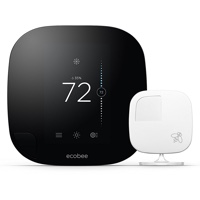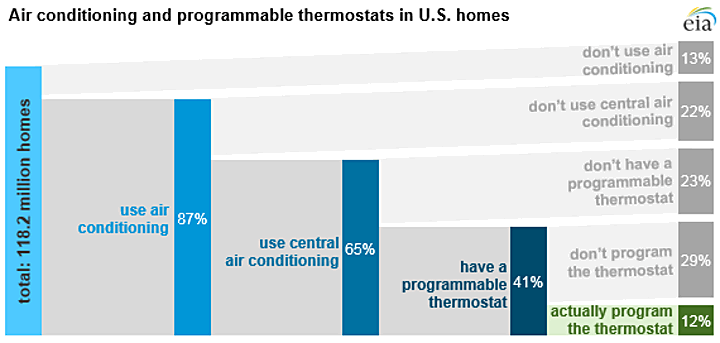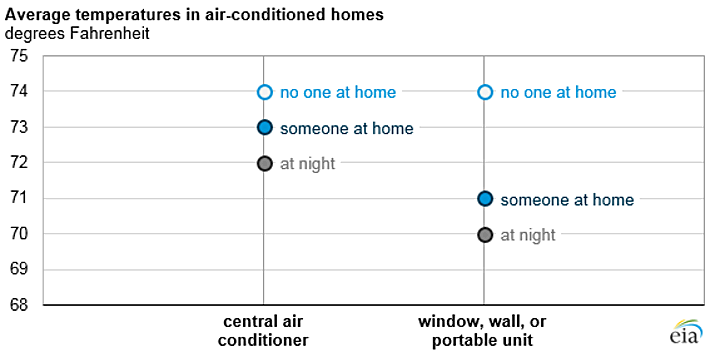 The hottest time of the year has arrived. The U.S. Energy Information Administration (EIA) shared some results from their 2015 Residential Energy Consumption Survey in regards to air conditioning.
The hottest time of the year has arrived. The U.S. Energy Information Administration (EIA) shared some results from their 2015 Residential Energy Consumption Survey in regards to air conditioning.
A programmable thermostat can save you a ballpark 15% on your cooling bill, with the average household saving $10-$15 per month. A programmable thermostat will adjust based on a preset schedule of when you expect to be home, away, or sleeping. Various studies (Nest whitepaper) have shown that you can save about 10% on heating and 15% on cooling, with the averaging household bill going down by about $10-$15 per month.
Prices start at only $20 for basic models, but you could theoretically break even in two years even with a fancy $250 thermostat. This highly-rated touchscreen model is $45 and this basic Honeywell version is only $20. Newer smart thermostats like the $250 Nest Thermostat and $250 ecobee4 can learn how you like the temperature and also work with WiFi and Amazon Alexa so you can change the settings wherever using your smartphone or with your voice.
So… you’d think they would be quite popular, right?

Less than 20% of homes with central air conditioning regularly use a programmable thermostat. Heck, only 30% of folks who already have a programmable thermostat installed actually use them. The article doesn’t explore the reasons behind this behavior. Maybe it’s just too complicated to program? They tried it and didn’t like it?
In case you’re curious, below are the average temperatures at which other people report setting their air-conditioning thermostat. Hmm… is it weird that my house is usually around 78 or 80 degrees?

Bottom line. Using a programmable thermostat is a pretty reliable way to save money your electricity bill. But for some reason, people don’t use them! Using a smart thermostat is a less reliable way to save money (higher upfront cost, lower marginal benefit over basic programmable thermostat), but if the alternative is doing nothing, then it could be worth the additional upfront investment.
 The Best Credit Card Bonus Offers – 2025
The Best Credit Card Bonus Offers – 2025 Big List of Free Stocks from Brokerage Apps
Big List of Free Stocks from Brokerage Apps Best Interest Rates on Cash - 2025
Best Interest Rates on Cash - 2025 Free Credit Scores x 3 + Free Credit Monitoring
Free Credit Scores x 3 + Free Credit Monitoring Best No Fee 0% APR Balance Transfer Offers
Best No Fee 0% APR Balance Transfer Offers Little-Known Cellular Data Plans That Can Save Big Money
Little-Known Cellular Data Plans That Can Save Big Money How To Haggle Your Cable or Direct TV Bill
How To Haggle Your Cable or Direct TV Bill Big List of Free Consumer Data Reports (Credit, Rent, Work)
Big List of Free Consumer Data Reports (Credit, Rent, Work)
Reason programmable thermostats are not widely used is because their user interfaces suck. The fancier ones like Nest and Ecobee have a better interface but are usually too pricey to justify. They’ll become more and more popular with rebates from energy companies, and with new houses wanting to advertise that they’re “smart houses”.
I just switched to a Nest thermostat last year and it is pretty awesome. It makes things a lot easier to be able to check and change the temperature from my phone or computer. When we are away, it goes into “Eco” mode and uses less energy, and then when we start home, I can set it to a comfortable temperature for when we return.
We’ve had a Honeywell programmable thermostat for years. No one is home for a good part of the day during the week, so it has been very useful to back off the cooling/heating during those times and have a more comfortable level kick in about a half-hour before my wife gets home. The only thing I dislike is that our model requires re-programming when the batteries are changed. Does anyone know if newer models can be hardwired? Jonathan, we work at acclimating ourselves to a somewhat higher AC setting as well — running ceiling fans a lot to help out.
I bought a cheapie ($25) Honeywell programmable thermostat 2 years ago from Home Depot and it holds the programming when I change the batteries.
People tend to look at this from their own perspective, and forget family situations are very different.
If you have a stay at home spouse / children, there are hardly any savings to be had with a programmable thermostat. There is not a predictable, consistent time of day with no one at home, so manual settings are the only way to do this. Even then, the savings aren’t that great – letting the house warm up while at the pool for two hours in the morning, only to have to cool it down again right after lunch in the heat of the day, doesn’t net out to much improvement.
People with pets that stay at the house all day also have numbers they don’t want to rise above or drop below, so that limits their range as well.
Other situations (older units that can’t catch up as well, humidity control requirements, etc) may have similar reasons to not take full advantage of this.
No idea what percentage of homes that covers, but I am the sort of person who would have no trouble installing and programming a thermostat, but see no payoff at all for my situation.
In my experience, they are not used because most people do not understand how to use them or find them too much trouble to deal with. Many people do not even understand simple thermostats.
I got a Nest a year ago and love it. I have it integrated with my Google OnHub router to instantaniously adjust the temperature upon connecting/disconnecting to my wifi.
That’s an interesting trick… I was just wondering if Nest/Ecobee works with geofencing.
I have a two-stage 21 seer heat pump. My HVAC guy was absolutely adamant that leaving the temperature setting unchanged was more efficient than having it change when away. He said that the smaller compressor would run most of the time that way. When a change of several degrees was called for from the thermostat, then either the bigger compressor, or both compressors would run. This is much less efficient, he tells me. Perhaps the programmable thermostat industry is not the best judge of how cost effective their products are.
I bought the Ecobee 3 with remote sensors. The initial programming was just as bad as a programable thermostat, but I like what I perceived to be more granular control than the learning system that Nest offers. We configured it to assume that we’re always gone during the day, but it uses the sensors + thermostat to determine occupancy, and adjusts appropriately. I liked the idea of geo-fencing, but the occupancy sensors work better for us.
I like the ability to “overcool” to reach a set humidity, not just temperature. 78 or 80 can be comfortable if the humidity is kept under control. There are programable heating / cooling ranges that set upper and lower limits to the temperature as well as the length of time before returning to the regular schedule. The remote sensors also help keep our house cooled evenly by not just relying on the temperature at the thermostat.
I don’t like the initial programming and wish it had humidity sensors on the remote devices. The customer support was awful both times I used it, but I would guess that most people wouldn’t need to call in.
All in all, I’m glad I bought it and look forward to the improvements in the Ecobee 4 or 5 for my next house.
Oh, nest. It assumes it is located in a place that you pass by frequently. If you don’t pass by and let it know you are home, you learn that your house will not be heated or cooled until you manually change it. It ignores my programming. The instructions are time consuming and don’t explain its actual behavior.
It’s the same reason people never programmed VCRs, they don’t understand how to set a program.
Only about 76M homes in the US are owner-occupied (https://www.statista.com/statistics/187576/housing-units-occupied-by-owner-in-the-us-since-1975/). If the person who owns the thermostat and the person paying the power bill are different, it may not make a lot of sense to upgrade, especially if you don’t know how long you’ll be staying, as is often the reason people continue to rent.